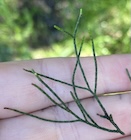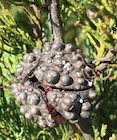Conservation Status

Callitris preissii
Miquel 1845
Common names
Rottnest Island pine, maroong [aboriginal] (ANBG 2002).
Taxonomic notes
Type: Australia, Western Australia, Rottnest Island, Jan. 1822, A. Cunningham 317. Most authorities in the 20th century thought of this as a widespread species, with occurrences across southern Australia from Perth to Melbourne, until the Flora of Australia (Hill 1998) recognized Callitris gracilis as the characteristic species of the Murray River area, with C. preissii confined mostly to the area around Perth, particularly Rottnest Island. The molecular analysis by Larter et al. (2017) supported this, placing C. gracilis in a clade with 5 other species, sister to C. preissii in a clade with two other species, these two clades having diverged about 10 million years ago (late Miocene).
Synonymy:
Most current authorities place C. tuberculata into synonymy with this species, but I follow Hill (1998) in treating it as a good species, which concurs with molecular evidence indicating C. tuberculata shares a clade with C. gracilis (Larter et al. 2017).
Description
Monoecious evergreen trees up to 20 m tall, single-stemmed with spreading to erect branches. Leaves 2-4 mm long on smallest twigs, gray-green or glaucous, abaxially rounded. Pollen cones cylindrical, clustered, up to 5 mm long. Seed cones solitary or grouped on stout, often clustered twigs, ovoid to depressed-globular, 25-30 mm diameter, persistent and retaining seed for several years after maturity; cone scales 6, thick, densely and coarsely tuberculate, occasionally with a very small dorsal point below the apex, not separating near base, not spreading widely after the cone opens, alternate scales reduced, larger scales apically abruptly obtuse; columella thick, entire, 3-angled, 2-4 mm high. Seeds numerous, dark brown, with 2-3 wings c. 4 mm wide (Hill 1998). See García Esteban et al. (2004) and Baker and Smith (1910, as C. robusta) for detailed characterization of the wood.
The morphological differences from C. gracilis are gray-green or glaucous foliage (vs. green), and a densely and coarsely tuberculate seed cone (vs. smooth or sparsely tuberculate). C. tuberculata is usually a multi-stemmed shrub, seed cones a bit smaller at 20-25 mm, and irregularly tuberculate.
Distribution and Ecology
Australia: Western Australia, "restricted to a relatively small area around Perth and on Rottnest Island ... locally common in calcareous sand deposits derived from old beach dunes" (Hill 1998). Note that under this definition, nearly all specimens commonly attributed to C. preissii in Western Australia (e.g. by the Atlas of Living Australia) are actually assignable to a much more widespread species, C. tuberculata.
Zone 10 (cold hardiness limit between -1°C and +4.4°C) (Bannister and Neuner 2001).
Although the IUCN lists this species as of "Least Concern" for conservation, that analysis conflates C. gracilis, C. preissii, and C. tuberculata. Given the very limited distribution of C. preissii within an area subject to ongoing urbanization, it likely is a species of conservation concern.
Remarkable Specimens
The oldest known specimen, 64 years, is documented in a tree-ring chronology covering the period 1912-1975 (fully crossdated), collected in just south of Perth (Western Australia) by V. C. Lamarche (doi.org/10.25921/cbsf-nx87). The 64-year lifespan was shown in one living tree.
Ethnobotany
No data as of 2024.12.05.
Observations
The species is most easily found and seen on Rottnest Island, a popular recreational destination served by a daily ferry from Perth.
Remarks
The epithet honors Johann August Ludwig Preiss (1811-1883), a German-born British botanist and zoologist who spent much of his life in Western Australia. He collected about 200,000 plant specimens there, representing possibly 4,000 species, and is remembered in the names of about 100 of them.
Citations
ANBG 2002. Australia National Botanical Garden, Aboriginal Trail page. http://osprey.erin.gov.au/anbg/aboriginal-trail.html, accessed 2002.01.18, now defunct.
Baker, R.T. and H.G. Smith. 1910. A Research on the Pines of Australia. Sydney: W.A. Gullick (p.99). Available: Biodiversity Heritage Library, accessed 2012.11.25.
Garden, J. 1957. A revision of the genus Callitris. Contributions from the New South Wales National Herbarium 2(5):384-385.
Larter, M., S. Pfautsch, J.-C. Domec, S. Trueba, N. Nagalingum, and S. Delzon. 2017. Aridity drove the evolution of extreme embolism resistance and the radiation of conifer genus Callitris. New Phytologist 215:97-112.
Miquel, F.A.G. 1845. Cupressinae Richard. V.1, p.643-645 in J.G.C. Lehmann, Plantae Preissianae. Hamburg.
National Register of Big Trees. 2018. [Unnamed document]. https://www.nationalregisterofbigtrees.com.au/tree_trivia_details_2018.pdf, accessed 2019.03.26.
See also
Farjon (2005) provides a detailed account, with illustrations.




